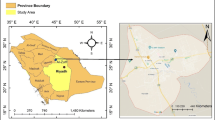Abstract
For the assessment of inhalation doses due to radon and its progeny to cavern workers and visitors, it is necessary to have information on the time integrated gas concentrations and equilibrium factors. Passive single cup dosimeters using solid state nuclear track detectors (SSNTD) is the best suited for this purpose in wadi Sannur cave, Beni Suef, Egypt. The average radon concentration measurements for the cave are 836 ± 150 Bq m–3 by CR-39 detectors and for equilibrium factor an overall average of all measured values was used 0.687. The effective dose for cave workers is 3.65 mSv/year while for visitors is 23 μSv/year. Comparing these values to the Ionizing Radiation Regulations (IRR) values which indicate that the estimated effective doses for workers and visitors in this cave are less than the average overall radon dose.
Similar content being viewed by others
References
Amin, Rafat M. (2005). Measurement of the radon gas concentration using different techniques, Ph.D Thesis, Cairo Univ., Beni Suef branch, Egypt.
Beck, T. R., Schmidt, V., & Ullmann, W. (1992). Optimierung eines neuen atzsystems fur kernspurdetektron unter dem aspect der anpassung empfindlickeit an die meBAufgabe, Jahresbericht, des BfS, Seiten 134–136.
Bottrell, S. (1991). Radon production and release from cave sediments. Cave Science, 18, 79–82.
Duenas, C., Fernandez, M. C., Canete, S., Carretero, J., & Liger, E. (1999). 222Rn concentrations, natural flow rate and the radiation exposure levels in the Nerja cave. Atmospheric Environment, 33, 501–510.
Duffy, J. T., Madden, J. S., Mackin, G. M., & McGarty, A. T. (1996). A reconnaissance survey of radon in show caves in Ireland. Environment International, 22(Suppl. 1), S415–S423.
Faulkner, K., & Gillmore, G. K. (1995). Geology and radon entry into buildings. In: The Radon Manual, (2nd ed.). A Guide to the requirements for the detection and measurement of natural radon levels, associated remedial measures and subsequent monitoring of results (2.21–2.29). Shepperton, Middlesex: The Radon Council Ltd.
Gillmore, G. K., Phillips, P. S., Denman, A. R., & Gilbertson, D. D. (2002). Radon in the Creswell Crags Permian limestone caves. Journal of Environmental Radioactivity, 62, 165–179.
Gunay, G., Ekmeci, M., Bayan, C., Kurttas, T., & El-Bedewy, F. (1997). A crescent shaped cave in Egypt. In: G. Gunay & A. Johnson (Eds.), Proceedings, symposium on karst waters and environmental impacts (pp. 257–263). Antalya, Turkey, 1995. A. A. Balkema, Rotterdam and New York.
International Commission on Radiological Protection (1993). Protection against radon-222 at home and at work. Oxford: Pergamon Press; ICRP Publication 65.
Ionising Radiations Regulations (1999) Health and Safety Executive, Statutory Instrument 3232, HMSO.
Jacobi, W. (1993). The history of tradon problem, chapter 3: Uranium mining and the rate of the radon daughters. In the International Commission of Radiological Protection: Protection against radon at home and at work. ICRP publication 65, Oxford: Pergamon Press.
Lario, J., Sanchez-Moral, S., Canaveras, J. C., Cuezva, S., & Soler, V. (2005). Radon continuous monitoring in Altamira Cave (northern Spain) to assess user’s annual effective dose. Journal of Environmental Radioactivity, 80, 161–174.
Miller, G. T. (2000). Living in the environment: principles, connections, and solutions (11st ed.). USA: Brooks/Cole.
Papachristodoulou, C. A., Ioannides, K. G., Stamoulis, K. C., Patiris, D. L., & Pavlides, S. B. (2004). Radon activity levels and effective doses in the Prema Cave, Greece. Health Physics, 86(6), 619–624.
Planinic, J., Radolic, V., Faj, Z., & Suveliak, B. (1997). Radon equilibrium factor and aerosol. Nuclear Instruments & Methods A, 396, 414–417.
Przylibski, T. A. (1999). Radon concentration changes in the air of two caves in Poland. Journal of Environmental Radioactivity, 45, 81–94.
Qureshi, A. A., Kakar, D. M., Akram, M., Khattak, N. U., Tufail, M., & Mehmood, K., et al. (2000). Radon concentrations in coal mines of Baluchistan, Pakistan. Journal of Environmental Radioactivity, 48(2), 203–209.
Sajo-Bohus, L., Greaves, E. D., Palfalvi, J., Urbani, F., & Merlo, G. (1997). Radon concentration measurements in Venezuelan caves using SSNTDS. Radiation Measurements, 28(I-6), 725–728.
Somogyi, G., Hunyadi, I., & Hakl, J. (1989). Historical revue of one decade radon measurements in Hungarian caves performed by SSNTDs. In Proc. of 10th Int. Conf. on Speleology, Budapest, Hungary, 1989. Rep. of Inst. Of Nucl. Res. No. 1–4/89, Debrecen, Hungary.
Thompson, A., Hine, P. D., Poole, J. S., & Greig, J. R. (1998). Environmental geology in land use planning: a guide to good practice. Report to the Department of the Environment, Transport and the Regions. Symonds Travers Morgan, East Grinstead, 80 pp.
Vaupotic, J., Csige, I., Radolic, V., Hunyadi, I., Planinic, J., & Kobal, I. (2001). Methodology of radon monitoring and dose estimates in Postojna cave, Solovenia. Health Physics, 80(2), 142–147.
Yamada, Y. (2003). Radon exposure and its health effects. Journal of Health Science, 49(6), 417–422.
Author information
Authors and Affiliations
Corresponding author
Rights and permissions
About this article
Cite this article
Amin, R.M., Eissa, M.F. Radon level and radon effective dose rate determination using SSNTDs In Sannur cave, Eastern desert of Egypt. Environ Monit Assess 143, 59–65 (2008). https://doi.org/10.1007/s10661-007-9957-y
Received:
Accepted:
Published:
Issue Date:
DOI: https://doi.org/10.1007/s10661-007-9957-y




